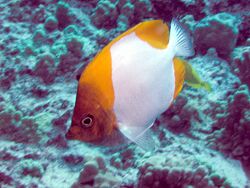Biology:Pyramid butterflyfish
| Pyramid butterflyfish | |
|---|---|

| |
| Scientific classification | |
| Domain: | Eukaryota |
| Kingdom: | Animalia |
| Phylum: | Chordata |
| Class: | Actinopterygii |
| Order: | Perciformes |
| Family: | Chaetodontidae |
| Genus: | Hemitaurichthys |
| Species: | H. polylepis
|
| Binomial name | |
| Hemitaurichthys polylepis (Bleeker, 1857)
| |
| Synonyms[2] | |
| |
The pyramid butterflyfish (Hemitaurichthys polylepis) is a species of marine ray-finned fish, a butterflyfish belonging to the family Chaetodontidae, native from central Indo-Pacific.
Description
The pyramid butterflyfish is a small-sized fish that can reach a maximum length of 18 cm.[3]
Its body is compressed laterally with a rounded body profile, and its snout protrudes forwards slightly with a small protrusible (extendable) mouth. Its very characteristic livery leaves no doubt about the identification. A dark brown-yellow area, the colour of which may vary in intensity, fully masks the head and extends to a line from the first rays of the dorsal fin to the start of its pelvic fins.[4]
The rest of its body is white, peduncle and caudal fin included. Insertion of yellow-orange areas at the top of the side form a characteristic pyramidal pattern, hence the name of the fish.[5] The anal fin is also yellow-orange.[4]
Distribution and habitat
The pyramid butterflyfish is widespread throughout the tropical and subtropical waters of the central Indo-Pacific from Cocos Keeling and Christmas Island to Polynesia and from south Japan to New-Caledonia. [1] [6]
The pyramid butterflyfish appreciates the outer reef slopes from which it can swim out into open water to get its food. It can be seen at depths from 3 to 60 meters deep.[7]
Biology
The pyramid butterflyfish lives in large schools, and feeds on plankton in open water out of its shelter reef.[8]
Conservation status
The species as a planktivorous could be affected by climate-induced reductions in planktonic productivity. There do not appear to be any current threats to this species and it is listed as Least Concern (LC) by the IUCN.[1]
References
- ↑ 1.0 1.1 1.2 Myers, R.F.; Pratchett, M. (2010). "Hemitaurichthys polylepis". IUCN Red List of Threatened Species 2010: e.T165672A6087416. doi:10.2305/IUCN.UK.2010-4.RLTS.T165672A6087416.en. https://www.iucnredlist.org/species/165672/6087416. Retrieved 19 November 2021.
- ↑ Froese, Rainer and Pauly, Daniel, eds. (2019). "Hemitaurichthys polylepis" in FishBase. December 2019 version.
- ↑ Lieske & Myers,Coral reef fishes,Princeton University Press, 2009, ISBN:9780691089959
- ↑ 4.0 4.1 Mark McGrouther (30 August 2019). "Pyramid Butterflyfish, Hemitaurichthys polylepis (Bleeker, 1857)". Australian Museum. https://australian.museum/learn/animals/fishes/pyramid-butterflyfish-hemitaurichthys-polylepis/. Retrieved 23 November 2020.
- ↑ Ricardo Pinto (2011). "Underrated fish – Pyramid Butterflyfish (Hemitaurichthys polylepis)". https://reefs.com/2011/08/06/underrated-fish-pyramid-butterflyfish-hemitaurichthys-polylepis/. Retrieved 23 November 2020.
- ↑ Myers, R.F., 1999. Micronesian reef fishes: a comprehensive guide to the coral reef fishes of Micronesia, 3rd revised and expanded edition. Coral Graphics, Barrigada, Guam. 330 p.
- ↑ Allen, G.R. and M.V. Erdmann, 2012. Reef fishes of the East Indies. Perth, Australia: University of Hawai'i Press, Volumes I-III. Tropical Reef Research.
- ↑ Randall, J.E., 1985. Guide to Hawaiian reef fishes. Harrowood Books, Newtown Square, PA 19073, USA. 74 p.
External links
- Photos of Pyramid butterflyfish on Sealife Collection
Wikidata ☰ Q2437382 entry
 |


